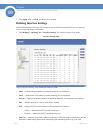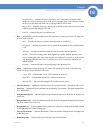
166
Chapter 10:
SFE2000/SFE2000P Gigabit Ethernet Switch Reference Guide
Chapter
10
Edit Rapid Spanning Tree Page
The Edit Rapid Spanning Tree Page contains the following fields:
• Interface — Displays the port or LAG on which Rapid STP is enabled.
• Role — Indicates the port role assigned by the STP algorithm in order to provide to STP paths. The
possible field values are:
– Root — Provides the lowest cost path to forward packets to root switch.
– Designated — Indicates that the port or LAG via which the designated switch is attached to
the LAN.
– Alternate — Provides an alternate path to the root switch from the root interface.
– Backup — Provides a backup path to the designated port path toward the Spanning Tree
leaves. Backup ports occur only when two ports are connected in a loop by a point-to-point
link. Backup ports also occur when a LAN has two or more connections connected to a
shared segment.
– Disabled — Indicates the port is not participating in the Spanning Tree.
• Mode — Indicates the current Spanning Tree mode. The Spanning Tree mode is selected in the
Global STP page. The possible field values are:
– Classic STP — Indicates that Classic STP is enabled on the device.
– Rapid STP — Indicates that Rapid STP is enabled on the device.
– Multiple STP — Indicates that Multiple STP is enabled on the device.
• Fast Link Operational Status— Indicates if Fast Link is enabled or disabled for the port or LAG. If
Fast Link is enabled for a port, the port is automatically placed in the forwarding state.
• Port State — Indicates if RSTP is enabled on the interface. The possible field values are:
– Enable — Indicates that RSTP is enabled on the port.


















